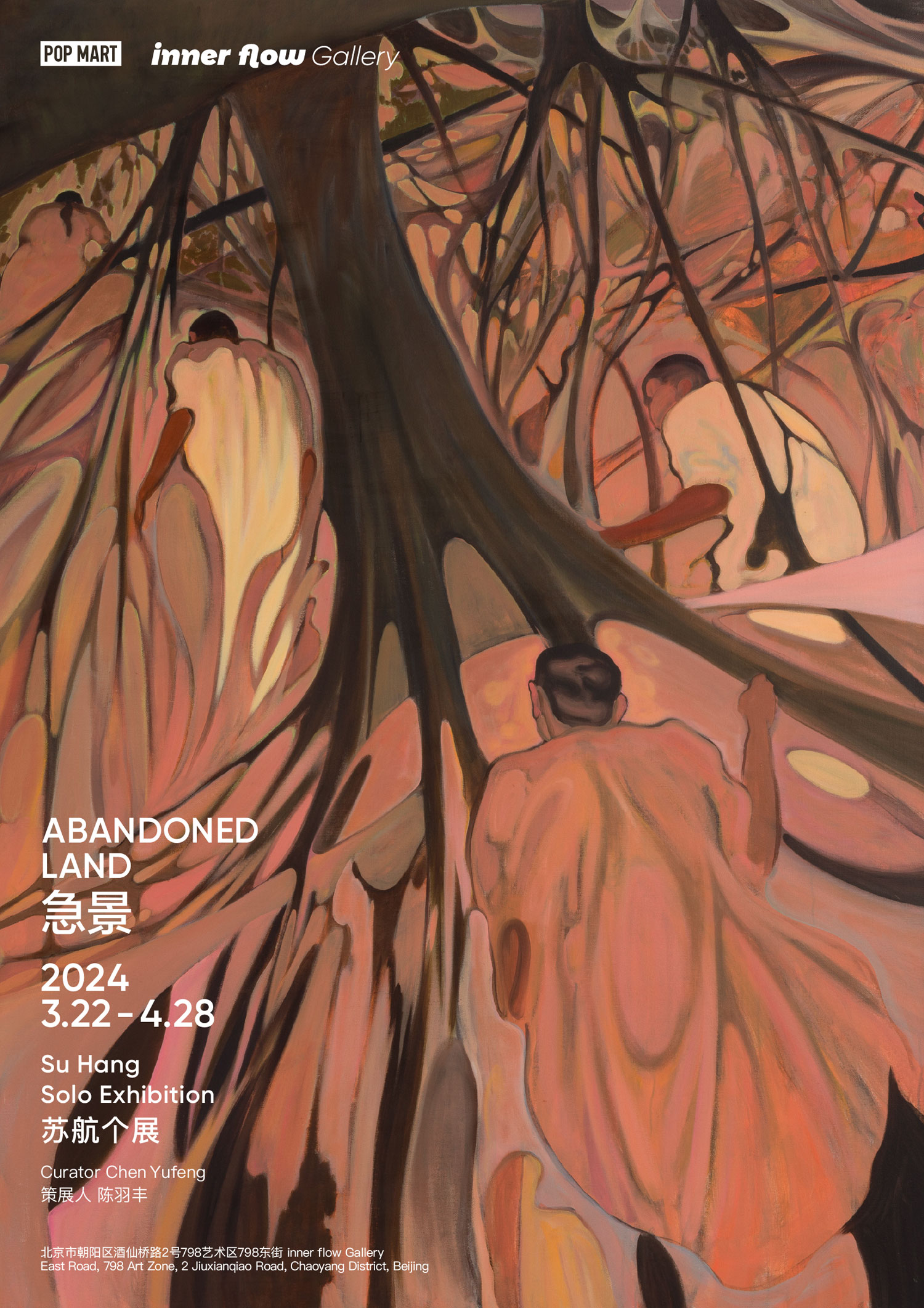展期 Period:
2024.3.22—2024.4.28
艺术家 Artist:
策展人 Curator:
地点 Venue:
新闻稿 Press Release:
inner flow Gallery将于2024年3月22日推出代理艺术家苏航的个展“急景”,展览将集中呈现艺术家近两年来创作的12件重要作品,这是艺术家在北京的首次个展。
经过一整个冬天,这些地方已经很久没有人去过。立春后,城郊的植被开始疯长,像劫后余生,盛大又荒芜,用一片春天的急景去纪念消失的这段时间。当人们再次踏入这旧旧的空地,没有明媚的阳光,就像从没来过的异境。
某种绵密黏稠的感觉在苏航的作品中萦绕,人物和环境像胶水一样粘连,世界笼罩在一片氤氲中。郊区、荒地、树林、不具体的人……被苏航在画布上放置、裂变、融合,编织出串联集体经验和个体想象的精神世界地图。
《林中路》系列作品中,苏航用一种“生长”和“编造”的方法构建结构庞杂的树林。每一个形状都是前一个事件裂变后的结果,像连锁反应,人物也以同样的方式被编进树林,背对画面朝更深处前进。于苏航而言,“编造”是从七年学院教育训练出的扎实“塑造”功底中的逃逸,也是警惕陷入“制造”的泥沼,去触达一种灵动诗意的可能。
《过河》、《老地方》、《玛丽亚》、《可能的别处》中,形象和情节则更加明确,携带丰富象征意味的元素也反复出现。“郊区”、“树林”成为上演荒诞剧的舞台,只有角色没有面目的演员沦为舞台道具的一部分。这些从现实改编的故事,可以看作是艺术家对现实的反应,而非说明;位于天际线后面的“太阳”,像在标注某些日复一日又转瞬即逝的时刻。然而作为携带巨大热量的天体,却不起到定位光源的作用,整个场景从来不会因为背后的太阳而显示出逆光的样子,反而云雾弥漫。
《地洞》、《戈多》、《具体的月亮》中,苏航将涌动的内在创作冲动投射到人物形象的实验中。画面中时空错乱的剪影、痉挛定格的身体,带有艺术家对当下AI图像生成热潮的紧迫性思考。从“输入”到“输出”,艺术家如何在“消化”的过程激活人性中的感性和情绪,将抽象的语言具象成富有鲜活生命力的视觉化作品。计算机算法理性、干净、高效,而人类大脑的记忆和想象却不是,会出错、依然困惑,我们不能背离艺术创作的原始冲动,径直走向工具和方法的漫漫长路。
苏航画中营造出的超现实空间缘于他对传统透视和图像叙事的解构。用多个图层的叠加效果替换前景和背景的遮挡关系,或在形与形之间挤压出轮廓线,又或由某一具体之物变幻至另一种状态。图像和语言就像苏航创作中的双生儿,它们彼此依存,相互借力,借图像所携带的信息刺激,适配一种新的绘画语言,再借绘画过程中的痕迹,去指导下一步行动,推导出新图像。观看苏航的作品,仿佛在观看世界于他大脑中重构的过程,抵达一个现实与虚构交叠的缓存地带。
展览将持续至2024年4月28日。
On March 22, 2024, inner flow Gallery will launch the solo exhibition Abandoned Land by artist Su Hang. This solo showcase in Beijing will feature 12 pivotal works created by the artist over the past two years, providing the viewer with a glimpse into his unique and captivating vision.
As the chill of winter fades, these forgotten landscapes awaken from their slumber. With the arrival of spring, suburban greenery erupts in a wild frenzy reminiscent of a post-apocalyptic resurgence, both grandiose and desolate. This sudden burst of life commemorates a period lost in time, where entering these old grounds feels akin to stepping into uncharted territory with no bright sunshine.
In Su Hang’s creations, there’s a palpable sense of density and viscosity, where figures and environments meld together like adhesive, enveloping the world in a haze of mystique. Suburbs, wastelands, forests, and enigmatic figures intertwine on canvas, weaving a tapestry that connects collective experiences and individual imaginations.
In the A Road in the Woods series, Su constructs intricately layered forests through a process of “growth” and “fabrication.” Each shape evolves from the fissure of the preceding event, creating a chain reaction of transformations. Figures, integrated into the forest, traverse deeper into the scene, their backs turned to the audience. For Su, “fabrication” breaks away from the solid foundation of “shaping” developed and trained during the seven college years, as well as the possibility of being wary of falling into the quagmire of “manufacturing” and reaching a spiritual and poetic realm.
Through works like Wading Across the Stones by Feeling for the River, Usual Place, Grow in the Shade, and The Possible and the Elsewhere, Su unveils surreal landscapes where reality blurs with fiction. Stories adapted from real life unfold against the backdrop of suburbs and forests as the sun, positioned behind the skyline as the stage for absurd dramas, marks fleeting moments that pass unnoticed. Yet, as a celestial body with immense heat, it remains shrouded, never casting its light upon the scene.
In Burrow, Godot, and Far and Near, Su explores the intersection of inner creativity and external reality, projecting the human experience onto experimental figures. These works reflect his contemplation of the current AI-generated image trend as he navigates the delicate balance between rationality and human emotion. From “input” to “output,” the artist activates the sensibility and emotions in human nature through “digestion” and translates the abstract language into vivid visual works. The computer algorithms that underpin AI-generated images may be characterized by their rationality, cleanliness, and efficiency, but they lack the memory and imagination of the human brain, which still makes mistakes and remains confused. We cannot deviate from the original impulse of artistic creation and walk straight toward the long road of tools and methods.
Su’s paintings transcend traditional perspectives, deconstructing visual narratives to create a surreal space where images and language intertwine. He replaces the occlusion relationship between foreground and background with the overlay effect of multiple layers, squeezes out contour lines between shapes, or transforms a specific object into another state. Su’s works rely on the relationship between image and language. They use the data stimuli carried by images to adapt to a new painting language and guide the next action through traces of the painting process to derive new images. His paintings display how the world is reconstructed in his brain, reaching a space where reality and fiction overlap.
The exhibition will last until April 28, 2024.

